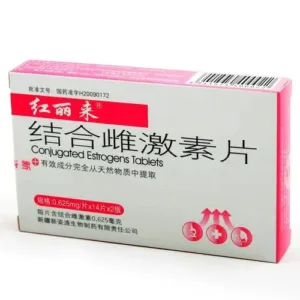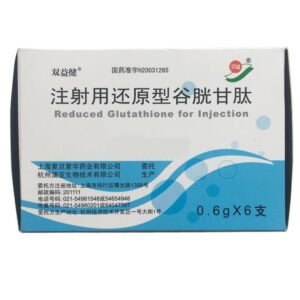Conjugated estrogens
Effects and efficacy:
Combined estrogen tablets are mainly used in the following situations. Treatment of moderate to severe vasomotor symptoms associated with menopause. Treatment of vulvar and vaginal atrophy. When used only for the treatment of vulvar and vaginal atrophy symptoms, vaginal topical medication products should be considered. Prevention and control of osteoporosis. When used only for the prevention and control of osteoporosis, it should only be considered for women at significant risk of osteoporosis and women who are considered unsuitable for non-estrogen therapy. Treatment of low estrogen due to hypogonadism, castration or primary ovarian failure. Treatment of metastatic breast cancer in appropriately selected women and men (for symptom relief only). Treatment of advanced androgen-dependent prostate cancer (for symptom relief only).
Usage and dosage:
Combined estrogen tablets are used orally, and the specific dosage should be followed according to the doctor’s advice. The same drugs produced by different manufacturers may have inconsistent instructions. If you find that the instructions are inconsistent before taking the drug, please consult a doctor or pharmacist in time. When estrogen therapy is given to postmenopausal women with a uterus, a progestin should be added to reduce the risk of endometrial cancer. Women without a uterus do not need to add a progestin. Estrogen alone or in combination with a progestin should be used at the lowest effective dose and for the shortest duration that balances the treatment goals and risks for the individual woman. Treatment of moderate to severe vasomotor symptoms and/or vulvar and vaginal atrophy associated with menopause When used solely for the treatment of vulvar and vaginal atrophy symptoms, vaginal topical products should be considered. Patients should be given the lowest effective dose. It is usually appropriate to start with 0.3 mg daily, and then the dose should be adjusted based on the individual patient’s response. The physician should re-evaluate the drug dose periodically to determine whether treatment is still necessary. Treatment can be done on a continuous or cyclical schedule, depending on the individual patient’s circumstances and medical needs. Prevention and control of osteoporosis When used solely for the prevention and control of osteoporosis, it should be considered only for women at significant risk for osteoporosis and those who are considered unsuitable for non-estrogen therapies. Patients should be treated with the lowest effective dose, usually starting with 0.3 mg daily, with subsequent doses adjusted based on the individual patient’s clinical response and bone mineral density response. The dose should be evaluated regularly by the physician to determine whether treatment is still necessary. Depending on the individual patient’s condition and medical needs, uninterrupted continuous therapy or cyclical dosing regimens can be used. Treatment of hypoestrogenism in women with hypogonadism due to hypogonadism, castration or primary ovarian failure: 0.3 mg or 0.625 mg per day, taken cyclically. Dose adjustment is based on the severity of symptoms and endometrial response. Existing data suggest that long-term use of 0.625 mg of this product with sequential use of progestins is sufficient to produce artificial cycles and maintain bone mineral density after skeletal maturity. Castration or primary ovarian failure: 1.25 mg per day, taken cyclically. Adjust the dose up or down based on the severity of symptoms and the patient’s response. To maintain efficacy, the dose can be adjusted to the lowest dose that effectively controls the disease. Treatment of appropriately selected female and male patients with metastatic breast cancer (for symptom relief only) is recommended to take 10 mg three times a day for at least 3 months. Treatment of advanced androgen-dependent prostate cancer (for symptom relief only) is 1.25 mg to 2.5 mg three times a day. Efficacy can be judged based on the results of phosphatase tests and the improvement of the patient’s symptoms. Patients should be evaluated by a physician regularly to determine the need for continued symptomatic treatment.
Adverse reactions:
The following adverse reactions may occur with short-term and long-term use of combined estrogen tablets. Potential serious adverse reactions are mainly breast and endometrial cancer, venous thrombosis, stroke and coronary artery disease. Reproductive system and breast: common breakthrough bleeding, spotting, breast pain, tenderness, enlargement, and discharge; changes in menstrual volume, changes in cervical os and cervical secretions are uncommon; dysmenorrhea, galactorrhea, and uterine smooth muscle enlargement are rare, and endometrial hyperplasia is very rare. Gastrointestinal tract: nausea, bloating, and abdominal pain are uncommon, vomiting and pancreatitis are rare. Nervous system: adverse reactions such as dizziness, headache, migraine, tension are uncommon; cerebrovascular accident and stroke, epilepsy exacerbation are rare; chorea exacerbation is very rare. Muscle, bone and connective tissue: joint pain and leg cramps are common. Mental disorders: changes in sexual desire, emotional instability, depression, dementia are uncommon, irritability is rare. Blood vessels: venous thrombosis is uncommon, superficial thrombophlebitis and pulmonary embolism are rare. Skin and subcutaneous tissue: alopecia is common, chloasma and black spots, hirsutism, itching, rash are uncommon, erythema multiforme and erythema nodosum are very rare. Infectious system: gallbladder disease is uncommon, cholestatic jaundice is very rare. Infection: vaginitis (including vaginal candidiasis) is uncommon. Benign and malignant tumors (including cysts and polyps): breast cancer, ovarian cancer, breast fibrocystic changes are rare, endometrial cancer, liver hemangioma enlargement are very rare. Immune system: urticaria, angioedema, allergies and anaphylactoid reactions are rare. Metabolism and nutrition: Decreased glucose tolerance is rare, porphyria aggravation and hypocalcemia are very rare. Eyes: Contact lens intolerance is uncommon, retinal vascular thrombosis is very rare. Heart: Myocardial infarction is rare. Respiratory system, thorax and mediastinum: Asthma aggravation is rare. Systemic and administration site: Edema is uncommon. Others: Weight changes and increased triglycerides are common, and increased blood pressure is very rare.
Drug contraindications:
Allergy to this product is prohibited. It is prohibited during pregnancy. It is prohibited for liver damage. Use with caution during lactation.
Share:
Products
Our offers
Health Classification
Let us work together to protect precious health

































